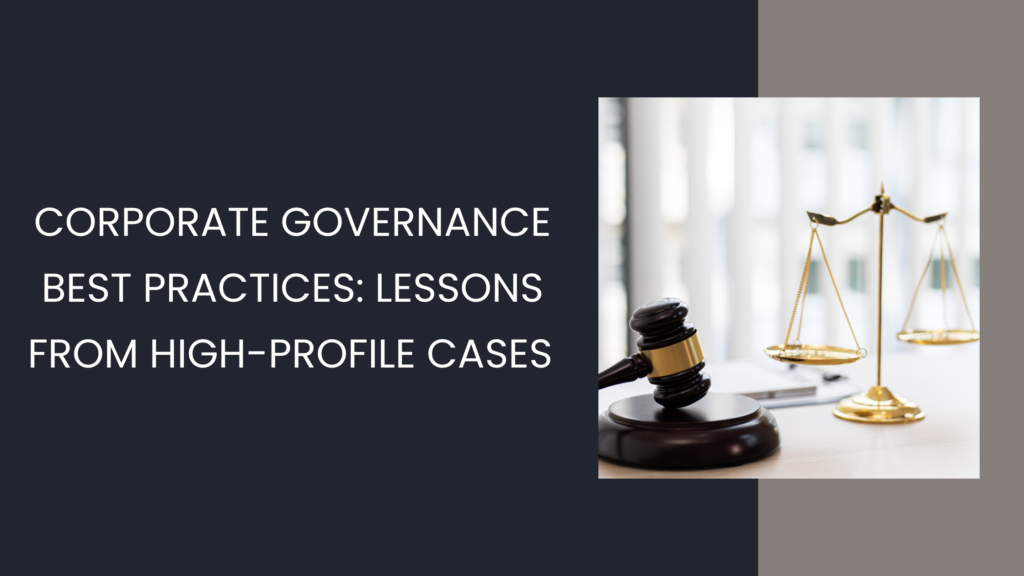Corporate governance plays a crucial role in the success and sustainability of a company. It involves a set of rules, practices, and processes that ensure a company is managed in a way that aligns with its goals and values while protecting the interests of stakeholders. High-profile corporate scandals and governance failures have often served as stark reminders of the importance of robust governance practices. In this blog, we explore key lessons from notable cases and outline best practices to help companies avoid similar pitfalls.
1. The Importance of Transparency: The Case of Satyam Computers
The Satyam Computers scandal in 2009 was a significant moment in corporate governance history. The company’s founder, Ramalinga Raju, admitted to a massive accounting fraud, inflating profits and manipulating financial statements to deceive shareholders and regulators.
Lesson: Transparency and Accurate Reporting
To avoid such issues, companies must ensure transparency in their financial reporting. This includes:
Accurate Financial Statements: Regularly audited and verified by independent auditors.
Clear Disclosure: Detailed and truthful disclosure of financial performance, risks, and related-party transactions.
Whistleblower Mechanisms: Establishing channels for employees and stakeholders to report unethical behavior without fear of retaliation.
2. Effective Board Oversight: The Enron Debacle
Enron’s collapse in 2001, one of the largest accounting scandals in history, highlighted severe failures in board oversight. The board, which was supposed to oversee management and ensure accurate reporting, failed to question the company’s aggressive accounting practices and complex financial structures.
Lesson: Strengthen Board Oversight
Best practices for effective board oversight include:
Independent Directors: Ensuring a majority of board members are independent and not involved in day-to-day operations.
Regular Reviews: Periodically reviewing financial reports, internal controls, and risk management processes.
Diverse Expertise: Having board members with diverse expertise and backgrounds to provide balanced perspectives.
3. Ethical Leadership: The Volkswagen Emissions Scandal
Volkswagen’s emissions scandal, revealed in 2015, involved the company installing software to cheat on emissions tests, misleading regulators and consumers. This scandal underscored the role of leadership in setting ethical standards.
Lesson: Promote Ethical Leadership
To foster an ethical culture, companies should:
Code of Conduct: Develop and enforce a comprehensive code of ethics that outlines acceptable behaviors and decision-making processes.
Leadership Example: Ensure top executives and directors model ethical behavior and emphasize its importance throughout the organization.
Training and Education: Provide regular training on ethical issues and legal compliance for all employees.
4. Accountability and Responsiveness: The Lehman Brothers Bankruptcy
The bankruptcy of Lehman Brothers in 2008, which was a key event in the global financial crisis, revealed deficiencies in risk management and accountability. The firm’s management and board failed to act on warning signs and adequately address financial risks.
Lesson: Enhance Accountability and Responsiveness
Companies can improve accountability and responsiveness by:
Risk Management: Implementing robust risk management frameworks to identify, assess, and mitigate risks.
Prompt Action: Ensuring timely action and decision-making in response to emerging risks and challenges.
Regular Audits: Conducting regular internal and external audits to assess the effectiveness of risk management and internal controls.
5. Regulatory Compliance: The Wirecard Scandal
The Wirecard scandal, which came to light in 2020, involved a fraudulent financial scheme where the company falsely reported having significant cash reserves. The scandal was a stark reminder of the need for rigorous regulatory compliance.
Lesson: Adhere to Regulatory Standards
Best practices for regulatory compliance include:
Adherence to Regulations: Staying updated with and complying with relevant laws and regulations.
Regular Compliance Checks: Conducting periodic compliance audits to ensure adherence to legal and regulatory requirements.
Engage Regulators: Maintain open communication with regulators and be proactive in addressing potential compliance issues.
Conclusion
High-profile corporate governance failures provide valuable lessons that can help companies build stronger governance frameworks and avoid similar mistakes. By embracing transparency, strengthening board oversight, promoting ethical leadership, enhancing accountability, and adhering to regulatory standards, companies can foster a robust governance structure that supports long-term success and stakeholder trust.


